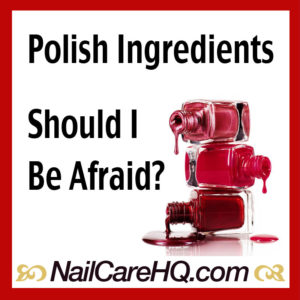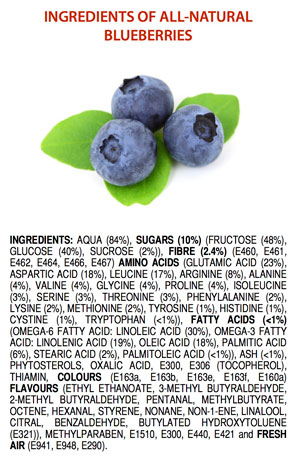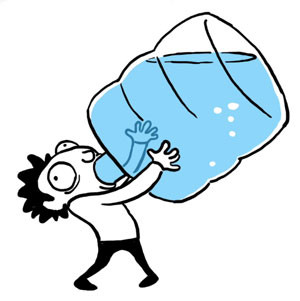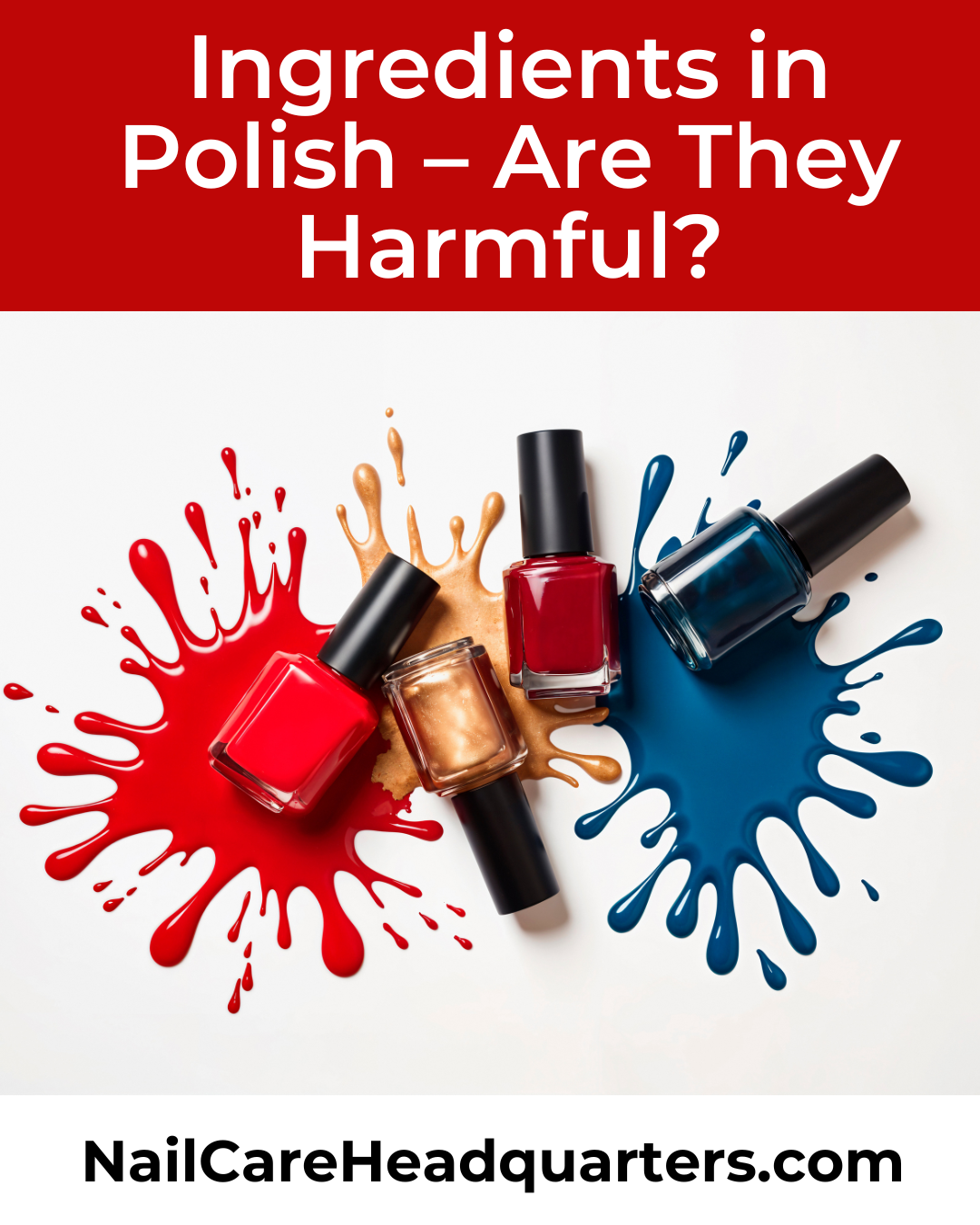INGREDIENTS IN POLISH

Do you worry whether the ingredients in polish are harmful?
Are you afraid the ingredients in polish might give you cancer?
In today’s article I’m going to discuss why it seems that we’re suddenly afraid of everything.
I’m also going to explain what different polish ingredients do to help us love adorning nails with pretty colors. And I’ll even manage to bring cake into the conversation!
Let’s look at a couple of words that play into our perception of products and services.
Marketing
According to BusinessDictionary.com, the definition of marketing is as follows.
The management process through which goods and services move from concept to the customer. It includes the coordination of four elements called the 4 P’s of marketing:
- Product: Identification, selection and development of a product.
- Price: Determination of its price.
- Place: selection of a distribution channel to reach the customer’s place.
- Promotion: Development and implementation of a promotional strategy.
Public Relations
Public relations (PR) is the practice of managing the spread of information between an individual or an organization (such as a business, government agency, or a nonprofit organization) and the public. Public relations may include an organization or individual gaining exposure to their audiences using topics of public interest and news items that do not require direct payment.
The aim of public relations is to inform the public, prospective customers, investors, partners, employees, and other stakeholders and ultimately persuade them to maintain a certain view about the organization, its leadership, products, or political decisions. [Source: En.wikipedia.org]
PR is a part of number four in the marketing section. It is a portion of a promotional strategy.
Notice how the aim of public relations is to “persuade” you to agree with the view of the organization. Hummm….
Chemophobia
Chemophobia, the unreasonable fear of chemicals, is a common public reaction to scientific or media reports suggesting that exposure to various environmental contaminants may pose a threat to health.—Stephen H. Safe, The New England Journal of Medicine, 30 Oct. 1997
The chemophobia phenomenon has been attributed to both a reasonable concern over the potential adverse effects of synthetic chemicals, and to an irrational fear of these substances because of misconceptions about their potential for harm. People marketing products react to widespread chemophobia with products marketed with an appeal to “nature.” en.wikipedia.org
Is Natural Better?
Everything has a chemical structure including water. Remember learning in school that water is one oxygen molecule and two hydrogen molecules? (H2O)
Take a look at the chemical ingredients in blueberries in the photo to the right.
That’s a lot of chemicals!
Yet, blueberries are incredibly good for us.
They combat aging, boost the brain, fight cancer, support digestion, promote heart health, benefit the skin, and aid in weight loss.
Natural Poisons?
Just because something is “natural” doesn’t mean it’s not poisonous.
These are the most toxic natural chemicals to the human body.
- Botulinum toxin (aka Botox)- botulism is caused by this protein and neurotoxin produced by bacteria spores
- Tetanospasmin– A neurotoxin produced by bacteria that causes Tetanus
- Palytoxin– narrows the blood vessels particularly large arteries and is found in a variety of marine life
- Diphtheria toxin– Is secreted by bacteria and causes diphtheria
- Ciguatoxin– A class of toxins found in certain fish that cause a foodborne illness called Ciguatera
- Batrachotoxin- A cardiotoxin and neurotoxin found in poison-dart frogs, melyrid beetles and certain birds
- Saxitoxin– a paralytic produced by shellfish
- Tetrodotoxin– A neurotoxin produced by a variety of marine life, most notably the puffer fish
- Ricin– (Breaking Bad fans may remember this one! ) It comes from castor beans and damages the ribosomes that carry out protein synthesis in cells
- Alpha-Amanatin– Causes liver failure and death and is found in mushrooms of the genus Amanita including the Death Cap
- Muscarine– a cardio and neuro toxin produced by certain mushrooms
- Aflatoxins– A class of fungal produced toxins and carcinogens that contaminate grains, peanuts and corn (Aflatoxin B1 is the most toxic in this class) [Source: chemicalsareyourfriends.com]
Can Water Kill?
 If you drink too much water in one day, you can die.
If you drink too much water in one day, you can die.
Hyponatremia, a word cobbled together from Latin and Greek roots, translates as “insufficient salt in the blood.” Severe cases of hyponatremia can lead to water intoxication, an illness whose symptoms include headache, fatigue, nausea, vomiting, frequent urination and mental disorientation.
In 2007 a 28-year-old California woman died after competing in a radio station’s on-air water-drinking contest. After downing some six liters of water in three hours in the “Hold Your Wee for a Wii” (Nintendo game console) contest, Jennifer Strange vomited, went home with a splitting headache, and died from so-called water intoxication.
There are many other tragic examples of death by water. In 2005 a fraternity hazing at California State University, Chico, left a 21-year-old man dead after he was forced to drink excessive amounts of water between rounds of push-ups in a cold basement.
Club-goers taking MDMA (“ecstasy”) have died after consuming copious amounts of water trying to rehydrate following long nights of dancing and sweating.
Going overboard in attempts to rehydrate is also common among endurance athletes. A 2005 study in the New England Journal of Medicine found that close to one sixth of marathon runners develop some degree of hyponatremia, or dilution of the blood caused by drinking too much water. [Source: Scientificamerican.com]
How Did We Get Here?
Rachel Carson’s book Silent Spring, published in 1962 was the greatest influence in sparking the modern environmental movement.
Ms. Carson was a marine biologist who worked for US Fish & Wildlife Service. She wrote, “[Chemicals are] the sinister and little-recognised partners of radiation… entering into living organisms passing from one to another in a chain of poisoning and death.” www.acs.org
These historical events also fueled our fears of poisonous chemicals.
- Thalidomide banned in 1961
- Minamata Bay disaster, Japan 1968
- Smoking and tobacco companies’ cover-up 1950s-70s
- Agent Orange used from 1961-71
- Times Beach disaster, Missouri 1970s
- DDT banned 1972
- Ozone depletion due to CFCs discovered 1974
- Love Canal disaster, New York 1976
- Bhopal disaster, India 1984
- Chernobyl disaster 1989
Notice how Ms. Carson writes that chemicals are partners of radiation?
Bringing attention to the global use of poisonous chemicals in the 1960s was important because we were unknowingly causing birth defects and slowly killing ourselves.
Unfortunately, the internet and social media have only fueled our chemophobia, and it’s spreading faster than a plague.
It’s gone too far.
Fear Based Activist Groups
There are so many activist groups who make broad reaching claims that are false.
Their unsubstantiated claims drive Doug Schoon, author of Nail Structure and Chemistry, and me nuts.
Unfortunately, the activist groups have large and dedicated staff who spend all of their time doing PR to promote their agenda.
We’ve all heard the misleading claims that nail polish is harmful, unless it’s “3-Free”. The facts are that all nail polish can be used safely and that’s been true for more than eighty years. Nail polish formulas haven’t changed much since the 1930’s.
How did they so suddenly become dangerous? I don’t know anyone who has been harmed by using nail polish, other than it catching fire. Fresh nail polish is flammable—so don’t do as my friend did and light up a cigarette immediately after polishing your nails.
How did all of this misinformation about nail polish get started? It started as a clever marketing campaign by a fear-based activist group. This group created a false safety concern and then cashed in on the donations, claiming they were saving the world from dangerous nail polish! They made exaggerated claims about the ingredients to needless frighten the public. ~Doug Schoon, Face-to-Face with Doug Schoon
Basic Polish Categories
Nail polish consists of a film-forming polymer dissolved in a volatile organic solvent.
Nitrocellulose that is dissolved in butyl acetate or ethyl acetate is common. This basic formulation is expanded to include the following:
- Plasticizers to yield non-brittle films. Dibutyl Phthalate and camphor are typical plasticizers.
- Dyes and pigments. Representative compounds include chromium oxide greens, chromium hydroxide, ferric ferrocyanide, stannic oxide, titanium dioxide, iron oxide, carmine, ultramarine, and manganese violet.
- Opalescent pigments. The glittery/shimmer look in the color can be conferred by mica, bismuth oxychloride, natural pearls, and aluminum powder.
- Adhesive polymers ensure that the nitrocellulose adheres to the nail’s surface. One modifier used is tosylamide-formaldehyde resin.
- Thickening agents are added to maintain the sparkling particles in suspension while in the bottle. A typical thickener is stearalkonium hectorite. Thickening agents exhibit thixotropy, their solutions are viscous when still but free flowing when agitated. This duality is convenient for easily applying the freshly shaken mixture to give a film that quickly rigidified.
- Ultraviolet stabilizers resist color changes when the dry film is exposed to sunlight. A typical stabilizer is benzophenone-1. en.wikipedia.org
“Toluene has been safely used in nail polish since the late 1930s. It is used to dissolve the other ingredients in nail polishes and treatments. Nail products with toluene will go on more smoothly and produce more brilliant colors that resist peeling. No other solvent does as good a job as toluene.” ~Doug Schoon, Nail Structure and Product Chemistry
How about Dibutyl phthalate (DBP)? Although this plasticiser hasn’t been used in polish for over a decade, and has been replaced by better plasticisers, it’s still included on the “scary” lists.
I find it fascinating that DBP is one of the touted “3-Free” ingredients, but it’s no longer in polish.
Why are we afraid of an ingredient that isn’t used anymore? Hummmm…
How to Bake a Cake
I know. This is an article about nails. But trust me, cake works in just about every situation. First a little more talk about chemicals.
Toluene sulfonamide formaldehyde resin (TSFR). According to Doug Schoon, this is the very best resin for polish.
TSFR isn’t toluene or formaldehyde. These substances were used to make a completely different ingredient and because they were made using these ingredients. (Now for the cake tie-in.)
The easiest way I can think to bring this TSFR confusion to a relatable level is by using a food example. How about cake?
You combine eggs, flour, oil, leavening and add oven heat to make a cake. The ingredients have been combined to create something completely different. The cake no longer tastes, smells or behaves like the included ingredients—but it’s certainly yummy!
It’s very much like this with TSFR. All of the ingredients in the name create the best resin for long wearing, durable polish. It’s unfortunate that the end result couldn’t be called “awesome resin.” Then we wouldn’t have a problem with it, right? (See? Cake works!)
Danger Signs
Are there times where we do need to worry about the ingredients in polish?
Yes.
The body has natural safety mechanisms to prevent us from doing things to ourselves that are harmful.
Polish
There is an incredible stamping polish that people absolutely love called Mundo de Uñas. It is a small Mexican company that was founded in 2013. The colors are vibrantly opaque.
Mundo de Uñas has refused to disclose ingredients which is illegal in many countries, so a lot of distributors have stopped stocking them.
I used this polish once and it caused an instant headache and I felt nauseous. I had to leave the room.
Although many people don’t have this reaction, it’s a vital warning sign. Your body experiences unpleasant symptoms as a warning sign to help keep you safe. Listen to your body.
Acetone
I unknowingly gave myself acetone poisoning when I was creating a bunch of how-to videos using the Simply Neat™ Miracle Mat™ in the Bliss Kiss™ warehouse.
I spent hours daily for two weeks removing polish on the mat. I experienced the classic symptoms of headache, nausea, dizziness, drowsiness and confusion. It took over a week of not being around acetone for me to feel better.
It’s incredibly important to have good ventilation when polishing your nails and using acetone.
Something Worse?
Bertha is a 23-year-old woman featured on TLC’s hit show My Strange Addiction in 2012, and she has a secret addiction that leaves her worried about her health. She has been addicted to drinking bottles of nail polish for at least five years. She drinks up to 5 bottles of polish a day. Bertha describes how the nail polish burns her throat, but says that it feels good to her. She eats 18 ounces a week. That’s nearly 36 gallons since her addiction began!
How well a person does depends on the amount of poison swallowed and how quickly treatment is received. The faster a person gets medical help, the better the chance for recovery. Nail polish tends to come in small bottles, so serious poisoning is unlikely if only one bottle was swallowed. However, always seek immediate emergency medical care.
Some people sniff nail polish on purpose to get intoxicated (drunk) by the fumes. Over time these people, as well as those working in poorly ventilated nail salons, can develop a condition known as “painter syndrome.” This is a permanent condition that causes walking problems, speech problems, and memory loss.
Painter syndrome may also be called organic solvent syndrome, psycho-organic syndrome, and chronic solvent encephalopathy (CSE). CSE can also cause symptoms such as headache, fatigue, mood disturbances, sleep disorders, and possible behavioral changes. [Source: Medlineplus.gov]
In Conclusion
I couldn’t find any follow up information about whether Bertha was able to quit drinking polish. But this is a great example of when it would be appropriate to worry about the health safety of the ingredients in nail polish.
It’s important to remember that our nails are dead—just like our hair is dead.
When we apply nail polish to our nails and it hardens, the health concerns about the ingredients aren’t justified.
Ultimately, we need to be very careful when listening to fear based groups who don’t share truthful information.
That’s why it’s so important to find sources that you can trust.
